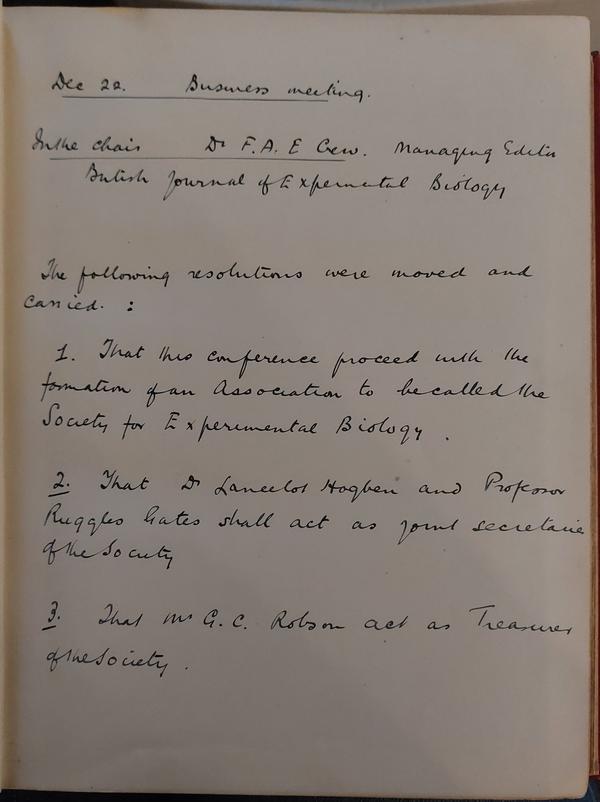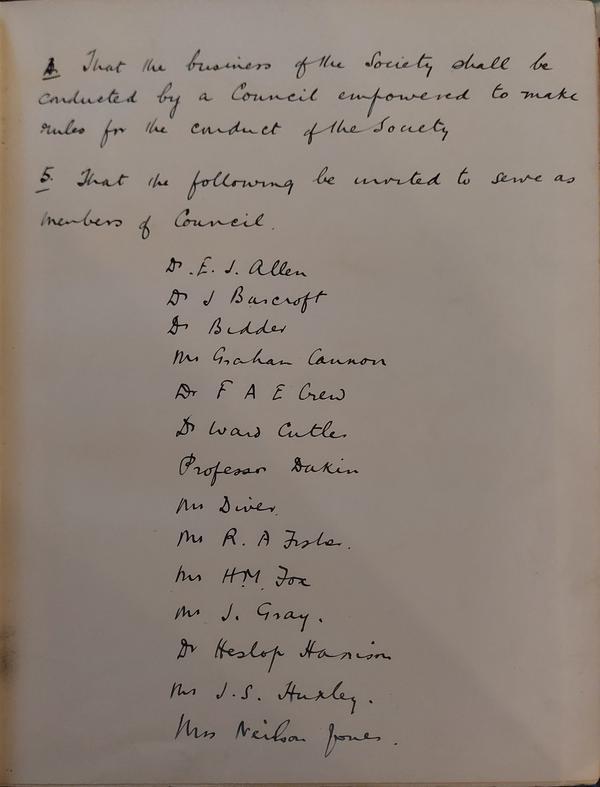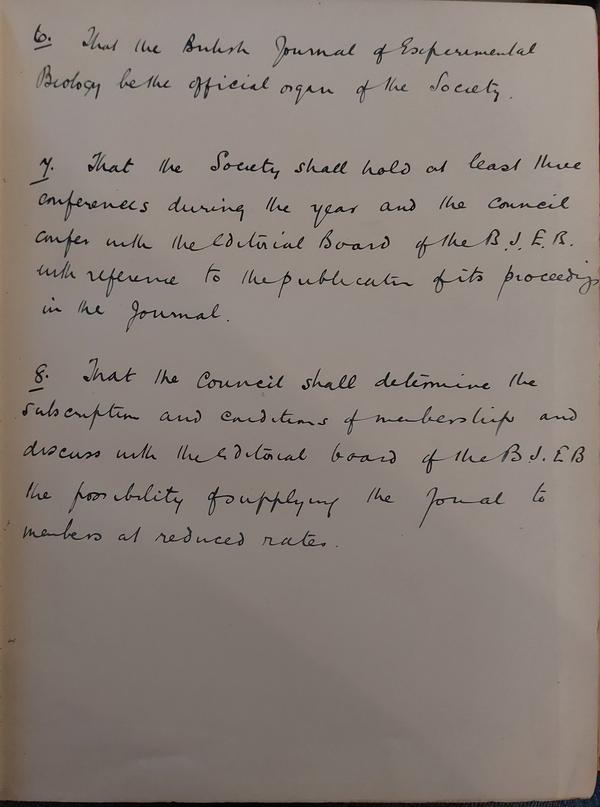SEB Organisation and Structure
This article was published as a chapter of the "Celebrating 100 years of SEB" book.
Resolutions from the first meeting
During the first meeting of SEB at Birkbeck College London 1923, a business meeting was held on the afternoon of 22nd December under the chairmanship of F.A.E. Crew. The following resolutions were made and members of the first Council appointed. This excerpt has been taken from Crew’s handwritten notes of that first meeting which are stored in the SEB archives.
Dec 22 Business Meeting
Chair - Dr F A E Crew. Managing Editor British Journal of Experimental Biology
The following resolutions were moved and carried:
- That this conference proceed with the formation of an Association to be called the Society for Experimental Biology.
- That Dr. Lancelot Hogben and Professor Ruggles Gates shall act as joint secretaries of the Society.
- That Mr. G.C. Robson act as Treasurer of the Society.
- That the business of the Society shall be conducted by a Council empowered to make rules for the conduct of the Society.
- That the following be invited to serve as members of Council:
- Dr E J Allen
- Dr J Bancroft
- Dr Bidder
- Mr Graham Cannon
- Dr F A E Crew
- Dr Ward Cutler
- Professor Dakin
- Mr Diver
- Mr R A Fisher
- Mr H M Fox
- Mr J Gray
- Dr Heslop Harrison
- Mr J S Huxley
- Mrs Neilson Jones
- That the British Journal of Experimental Biology be the official organ of the Society.
- That the Society shall hold at least three conferences during the year, and the Council shall confer with the Editorial Board of the BJEB with reference to the publication of its proceedings in the Journal.
- That the Council shall determine the subscription and conditions of membership and discuss with the editorial board of the BJEB the possibility of supplying the Journal to members at reduced rates.

The handwritten minutes of the first SEB meeting in 1923 (page 1).

The handwritten minutes of the first SEB meeting in 1923 (page 2).

The handwritten minutes of the first SEB meeting in 1923 (page 3).
First Invited members of Council
The following list provides a glimpse into the individuals who were instrumental in the formation of the Society for Experimental Biology (SEB) and were invited as the first members of Council during its inaugural meeting in 1923.
- Edgar Johnson Allen (1866 – 1942) - A distinguished British marine biologist; Fellow of the Royal Society; recipient of the Gold Medal of the Linnean Society in 1926; and the Royal Society's Darwin Medal in 1936.
- Sir Joseph Barcroft (1872 – 1947) - Renowned British physiologist celebrated for pioneering research on blood oxygenation.
- George Parker Bidder (1863 – 1953) - Eminent British marine biologist, specializing in sponge studies, and President of the Marine Biological Association (MBA) from 1939 to 1945.
- Herbert Graham Cannon (1897 – 1963) - A leading English zoologist and advocate of Lamarckism.
- Francis Albert Eley Crew (1886 - 1973) - An English animal geneticist. He was a pioneer in his field leading to the University of Edinburgh’s place as a world leader in the science of animal genetics. He was the first Director of the Institute of Animal Breeding and the first Professor of Animal Genetics. He is said to have laid the foundations of medical genetics.
- Donald Ward Cutler (1892 – 1941) - A biologist known for early research at the Marine Biological Station in Plymouth and later contributions in amoebic.
- William John Dakin (1883 – 1950) - A zoologist who is remembered for the large number of his students who achieved prominence in the area of zoology and for the number of textbooks and papers he wrote across an array of disciplines.
- Captain Cyril Diver (1892 – 1969) - A dedicated civil servant and amateur naturalist who became the first Director-General of the Nature Conservancy.
- Sir Ronald Aylmer Fisher (1890 – 1962) - A British polymath who excelled in mathematics, statistics, biology, genetics, and academia.
- Harold Munro Fox (1889 – 1967) - An esteemed English zoologist with a focus on marine invertebrates and recipient of the Royal Society's Darwin Medal in 1966.
- Reginald Ruggles Gates (1882 –1962) - A Canadian-born geneticist who published widely in the fields of botany and known for his studies of Oenothera and other plants. Regrettably, he was also a proponent of eugenics and human race theories, a form of scientific racism that has had long lasting negative effects for people across the world even to this day. His beliefs on the matter eventually led to very public disagreements with prominent SEB members, including both Hogben and Huxley, who vehemently denounced his views.
- Sir James Gray (1891 – 1975) - Professor of Zoology known for his work in cytology, animal locomotion, and Gray's Paradox concerning dolphin locomotion.
- Prof John William Heslop Harrison, FRS FRSE (1881 – 1967) - A respected Professor of Botany at King's College, Durham University (now Newcastle University) specializing in moth genetics and associated with an alleged academic controversy.
- Lancelot Thomas Hogben (1895 - 1975) - A British experimental zoologist who developed the African clawed frog (Xenopus laevis) as a model organism for biological research and wrote popular books on science. He was also an outspoken activist against the harmful eugenics movement.
- Sir Julian Sorell Huxley (1887 – 1975) - A distinguished British evolutionary biologist. He was the first Director of UNESCO, a founding member of the World Wildlife Fund, and the first President of the British Humanist Association.
- Mabel Mary Cheveley Rayner (noted by her married name, Mrs Neilson-Jones in the minutes from 1923) (1890-1948) - An English botanist specialized in mycology, who published books and articles on plant physiology and was one of the first to propose that mycorrhizal interactions could both help and harm plants.
Past Presidents
Over the span of a century, SEB has seen 60 individuals assume the leadership roles of President, Treasurer, and Secretary. In its early years, from 1923 to 1975, pivotal governance and responsibilities were jointly held by the Society's Secretaries and Treasurer. During the inaugural SEB Conference in 1923, the decision was made to entrust Dr Lancelot Hogben with the role of zoological and physiological secretary, Professor Ruggles Gates undertook the position of botanical secretary, and Guy Coburn Robson was elected Treasurer.
In 1977, a significant development occurred when the first President was appointed. This transformation was simultaneous with the Society's incorporation as a company. John William Sutton Pringle assumed the role of the first President, setting a tradition where each successive term would see a President with a background in either animal or plant biology research. This approach aimed to provide equitable representation, alternating between the earlier joint leadership roles of Zoological Secretary and Botanical Secretary. It was later established that each of the three scientific sections would take turns in nominating candidates for the next President. This rotation ensured that the President would have a background in Animal, Cell, or Plant biology in alternating terms. We believe Adam Sebastian Genevieve Curtis election as President in 1991 makes him the first President to represent the Cell Biology section, marking an evolution in SEB's leadership structure.
|
Dates of Service |
Name |
|---|---|
|
1923/1925 |
L.T. Hogben (Secretary) |
|
1923/1926 |
G.C. Robson (Treasurer) |
|
1923/1928 |
R. Ruggles Gates (Secretary) |
|
1926/1928 |
C.F.A. Pantin (Secretary) |
|
1926/1934 |
W.Neilson Jones (Treasurer) |
|
1929/1933 |
W.H.Pearsall (Secretary) |
|
1929/1936 |
G.P. Wells (Secretary) |
|
1934/1937 |
E. Ashby (Secretary) |
|
1935/1937 |
G. Salt (Treasurer) |
|
1937/1943 |
J. Z. Young (Secretary) |
|
1938/1940 |
J.E. Harris (Treasurer) |
|
1938/1945 |
T. A. Bennet-Clark (Secretary) |
|
1941/1947 |
H. C. Gilson (Treasurer) |
|
1944/1948 |
J. F. Danielli (Secretary) |
|
1946/1949 |
R. Brown (Secretary) |
|
1948/1949 |
M. E. Brown (Treasurer) |
|
1949/1952 |
M. M. Swann (Secretary) |
|
1950/1952 |
J. W. L. Beament (Treasurer) |
|
1950/1953 |
W. T. Williams (Secretary) |
|
1953/1954 |
C. B. Goodhart (Treasurer) |
|
1953/1955 |
J. W. L. Beament (Secretary) |
|
1954/1956 |
R Scott Russell (Secretary) |
|
1955/1974 |
O. V. S. Heath (Treasurer) |
|
1956/1959 |
J. D. Carthy (Secretary) |
|
1957/1960 |
G. E. Fogg (Secretary) |
|
1960/1964 |
S. M. McGee Russell (Secretary) |
|
1961/1965 |
J. F. Sutcliffe (Secretary) |
|
1965/1968 |
M. A. Sleigh (Secretary) |
|
1966/1970 |
B. C. Loughman (Secretary) |
|
1969/1972 |
A. P. M. Lockwood (Secretary) |
|
1971/1975 |
N. Sunderland (Secretary) |
|
1973/1976 |
P. Spencer Davies (Secretary) |
|
1974/1975 |
J. Edelman (Treasurer) |
|
1975/1976 |
J.E. Dale (Secretary) |
|
1975/1976 |
E.J. Binyon (Treasurer) |
|
1977/1979 |
John William Sutton Pringle |
|
1979/1981 |
Paul Egerton Weatherley |
|
1981/1983 |
J. Shaw |
|
1983/1985 |
Sir David Cecil Smith |
|
1985/1987 |
Peter Norman Russell Usherwood |
|
1987/1989 |
Harold William Woolhouse |
|
1989/1991 |
Ernest Naylor |
|
1991/1993 |
Adam Sebastian Genevieve Curtis |
|
1993/1995 |
Paul Gordon Jarvis |
|
1995/1997 |
Robert McNeill Alexander |
|
1997/1999 |
John Albert Raven |
|
1999/2001 |
David Thomas Clarkson |
|
2001/2003 |
William (Bill) Mordue |
|
2003/2005 |
John Bryant |
|
2005/2007 |
Roger Leigh |
|
2007/2009 |
Ian Alistair Johnston |
|
2009/2011 |
Patrick Heslop Harrison |
|
2011/2013 |
Keith Lindsey |
|
2013/2015 |
Anthony (Tony) P. Farrell |
|
2015/2017 |
Patrick J. Hussey |
|
2017/2019 |
Christine Raines |
|
2019/2021 |
Craig Franklin |
|
2021/2023 |
Jim Murray |
|
2023/2025 |
Tracy Lawson |
Executive team
As the Society continued to expand and the demands of managing conferences, memberships, and administration became increasingly substantial, Council recognised the need for additional support. Initially, this was achieved by appointing a Deputy Treasurer, a role which was later replaced with the role of Publications Officer. Then, in 1954, the Society entered into an agreement with the Institute of Biology, a professional organisation for biologists and umbrella body for various learned biological societies in Britain, who later merged with the Biosciences Federation and gained a Royal Charter to become the Royal Society of Biology. The SEB’s agreement with the Institute involved an annual payment that covered the employment of a person within the Institute on a part-time basis to help look after membership records, journal subscriptions, and general accounts.
In 1975, as the SEB's scope expanded to encompass publications, trade displays, and increased international involvement, an executive office was established at Harvest House in Reading, UK. A part-time executive secretary was appointed to alleviate the administrative responsibilities previously handled by the Society's Treasurers and Secretaries, marking the end of the agreement with the Institute of Biology. The first documented staff member at the SEB, Mrs. M. D. Eddy, was mentioned in a 1975 SEB newsletter, where she was recognised for her administrative role, particularly related to membership inquiries and subscription fees.
Today, the SEB benefits from the dedicated efforts of ten full-time staff members within its executive office, in addition to the journal staff based at Lancaster University. The executive team manages a wide array of tasks, including membership administration, communication, website management, event coordination, and public engagement and outreach. At the helm of these operations, the Chief Executive Officer oversees the Society's operations, strategic direction, and corporate decisions. The journal staff at based at Lancaster University take charge of the Journal of Experimental Botany and other publication activities. These professionals play a pivotal role in ensuring the day-to-day operations and growth of the SEB, enabling its continued success and expansion.
Incorporation as a Company
Following a decision made during the SEB meeting in Manchester on 30th March 1977, Council granted authorisation to the Society's officers to proceed with the steps to incorporate as a company. Subsequently, on the 26th April the subscribers to the Memorandum and Articles of Association, after minor revisions required by the Department of Trade, officially appointed the first officers of the incorporated Society:
- J. W. S. Pringle as President
- P. E. Weatherley as Vice-President
- J. E. Dale as Botanical Secretary
- G. Shelton as Zoological Secretary
- E. J. Binyon as Treasurer
- J. W. Hannay as Publications Officer
Several Council members were also officially appointed at this time: J. N. Brady, D. T. Clarkson, M. W. Steer, B. M. H. Bush, D. Grierson, J. Lackie, G. J. Goldsworthy, D. H. Jennings, and J. A. Riegel.
During this period, the Society restructured, introducing scientific sectional committees for animal, plant, and cell biology, as well as a President's committee responsible for ensuring the Society's smooth operation. The animal biology and plant biology committees were headed by G. Shelton as Zoological Secretary and J. E. Dale as Botanical Secretary respectively, and the cell section was chaired by P. Spencer Davies as convener. They met for the first time in late May 1977 to begin detailed planning of upcoming SEB meetings. The President's committee encouraged the scientific sections to forge connections with European Societies, akin to the plant section's involvement in organising the inaugural meeting of the Federation of European Societies of Plant Physiology at the 1978 SEB Meeting in Edinburgh. Subsequently, the animal section invited European Comparative Animal Physiologists to the SEB meeting in York in 1979, with the aim of establishing a European association.
Special Interest Groups
Special Interest Groups have played an integral role in the SEB's evolution. They form sub-communities within SEB who have a shared interest in a specific field with the aim of advancing research, knowledge, and learning in that area. The inception of Special Interest Groups in 1975 began with the Neurobiology Group, led by M. Burrows, alongside committee members G. Horn, G. A. Kerkut, and P. N. R. Usherwood. Their contributions to the meeting at Queen Mary College in December 1975 - a session with six papers, chaired by J. Palka - set the stage for the formation of other Special Interest Groups.
Following this success, 1976 saw the proposal of four additional Special Interest Groups:
- The Nucleic Acid and Protein group, spearheaded by D. Boulter, with committee members M. R. Hatley and A. P. Sims.
- The Plant Growth and Substance group, convened by J. Hillman, and supported by D. J. Osborne, P. F. Wareing, and D. L. Laidman.
- The Respiration Group, with P. J. Butler as Convener, along with committee members B. L. Bayne, D. M. Dennison, and G. M. Hughes, planning sessions on "anaerobiosis and environmental hypoxia" and "control of ventilation."
- The Environmental Physiology Group, emerging as a response to the need for a niche within the learned society for environmental physiologists.
New Special Interest Groups have been proposed to Council over the last 45 years, with regular reviews to ensure alignment with the evolving interests of the experimental biology community. Presently, there are 23 active Special Interest Groups. These groups contribute to organising sessions at the Annual Conference and Symposia. Each Special Interest Group is led by a dedicated convenor, and collectively, these convenors form the SEB Scientific Section Committees. The current Special Interest Groups encompass a diverse range of topics, reflecting the vibrant landscape of experimental biology:
- Abiotic Stress and Climate Change Group
- Animal Biomechanics Group
- Animal Ecophysiology Group
- Animal Osmoregulation Group
- Animal Respiration Group
- Cellular Function Group
- Comparative Endocrinology Group
- Conservation Physiology Group
- Crop Molecular Genetics Group
- Cytoskeleton and Cytosolic Organization Group
- Emerging Technologies Group
- Interaction of Plants with other Organisms Group
- Modelling and In Silico Biology Group
- Neurobiology Group
- Nuclear and Chromatin Dynamics Group
- Outreach, Education, and Diversity Group
- Photosynthesis and Metabolism Group
- Plant Biotechnology and Synthetic Biology Group
- Plant Development Group
- Plant Environmental Physiology Group
- Plant Transport Group
- Synthetic Biology and Industrial Biotechnology Group
- Thermobiology Group
